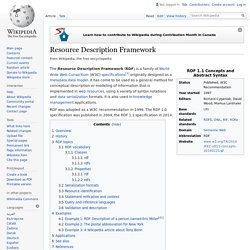

Resource Description Framework. The Resource Description Framework (RDF) is a family of World Wide Web Consortium (W3C) specifications[1] originally designed as a metadata data model.

It has come to be used as a general method for conceptual description or modeling of information that is implemented in web resources, using a variety of syntax notations and data serialization formats. It is also used in knowledge management applications. RDF was adopted as a W3C recommendation in 1999. The RDF 1.0 specification was published in 2004, the RDF 1.1 specification in 2014. Overview[edit] RDF is an abstract model with several serialization formats (i.e. file formats), so the particular encoding for resources or triples varies from format to format. As RDFS and OWL demonstrate, one can build additional ontology languages upon RDF. History[edit] The W3C published a specification of RDF's data model and an XML serialization as a recommendation in February 1999.[9] RDF topics[edit] RDF vocabulary[edit] Classes[edit] rdf[edit] rdfs[edit] <? Quick Intro to RDF. Quick Intro to RDF This is a really brief introduction to Resource Description Framework (RDF).
You might also be interested in... For a more detailed look at RDF, see RDF in Depth on this site, which this page was based on. Two video introductions to the Semantic Web and RDF and RDFa by Manu Sporny are very good. Ian Davis's RDF Tutorial slides are also very good. RDF is a method for expressing knowledge in a decentralized world and is the foundation of the Semantic Web, in which computer applications make use of distributed, structured information spread throughout the Web. The Big Picture RDF is a general method to decompose any type of knowledge into small pieces, with some rules about the semantics, or meaning, of those pieces. @prefix : < . The meaning is obvious. If you know XML, here's a brief comparison. But you don't have to use XML. What really sets RDF apart from XML and other things is that RDF is designed to represent knowledge in a distributed world. So why use RDF?
RDF Primer. The Resource Description Framework (RDF) is a language for representing information about resources in the World Wide Web.

This Primer is designed to provide the reader with the basic knowledge required to effectively use RDF. It introduces the basic concepts of RDF and describes its XML syntax. It describes how to define RDF vocabularies using the RDF Vocabulary Description Language, and gives an overview of some deployed RDF applications. It also describes the content and purpose of other RDF specification documents. 1. The Resource Description Framework (RDF) is a language for representing information about resources in the World Wide Web. RDF is intended for situations in which this information needs to be processed by applications, rather than being only displayed to people.
RDF is based on the idea of identifying things using Web identifiers (called Uniform Resource Identifiers, or URIs), and describing resources in terms of simple properties and property values. <? 2. (URL). RDF tools. RDF. Frameworks.